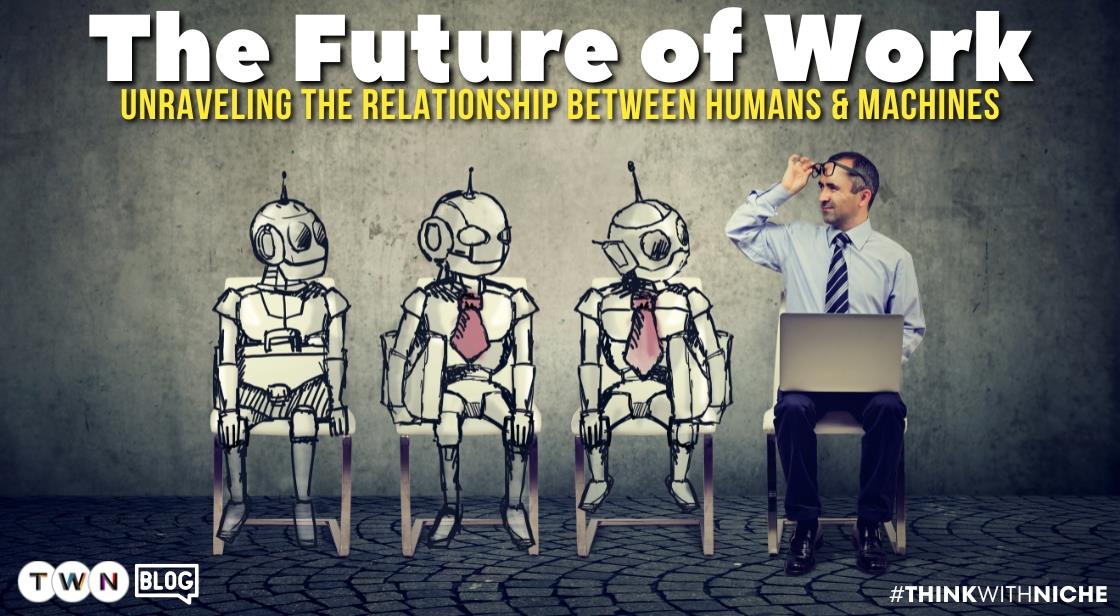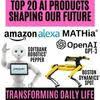Are Humans and Machines Collaborating or Competing?: Humans vs. Machines

Blog Post
The interplay between humans and machines is undergoing a fundamental shift. As artificial intelligence (AI) rapidly evolves, the narrative is moving beyond simplistic fears of machines replacing humans. Instead, we are witnessing the rise of collaborative AI, where humans and machines are joining forces to achieve remarkable feats.
This paradigm shift necessitates a balanced approach, fostering collaboration while acknowledging the complexities and challenges it presents.
In the dynamic landscape of 2024, the collaboration between humans and machines has transcended hypothetical scenarios, becoming a tangible force reshaping industries globally. The phenomenon of Human-Machine Collaboration (HMC) has evolved from a theoretical concept to a practical reality, exerting a transformative influence on how we approach work, innovation, and complex problem-solving.
This blog delves into the intricate dance between humans and machines, exploring various aspects of this evolving relationship. We will examine the immense potential of collaborative AI across diverse fields, from healthcare and manufacturing to art and design.
We will also explore the ethical considerations, potential job displacement concerns, and the crucial role of education and reskilling in this human-machine future.
Through powerful examples and insightful analysis, we aim to navigate the complexities of this shifting landscape.
We will showcase how human-machine collaboration is not just science fiction, but a tangible reality with the potential to revolutionize our world.
So, join us as we explore the exciting possibilities and navigate the challenges of this collaborative future, where humans and machines work together to shape a more prosperous and sustainable world.
Unraveling the Relationship Between Humans and Machines:The Future of Work
Collaboration and Coexistence: Embracing the Rise of Collaborative AI
The landscape of artificial intelligence (AI) is undergoing a fascinating transformation. Gone are the days of simplistic narratives about machines replacing humans. Instead, we're witnessing the rise of collaborative AI, where humans and machines are joining forces to achieve remarkable feats. This shift represents a crucial paradigm shift, moving from automation-centric approaches to leveraging the unique strengths of both entities.
Human-Machine Teaming: A Symbiotic Relationship in the Workplace
The workplace is a prime example of this collaborative revolution. Instead of fearing robotic replacements, employees are increasingly working alongside AI-powered tools and robots. This human-machine teaming has the potential to dramatically reshape work environments, leading to:
-
Increased Productivity and Efficiency: Imagine a surgeon relying on an AI-powered assistant that provides real-time data analysis and guidance during complex procedures. Or, picture a factory worker collaborating with a robot that handles repetitive tasks, freeing them up for more strategic thinking and problem-solving. These scenarios illustrate how human-machine teams can achieve significantly higher levels of productivity and efficiency than either could alone.
-
Enhanced Decision-Making: Data is the new currency, but analyzing vast amounts of information can be overwhelming. AI excels at crunching numbers and identifying patterns, providing valuable insights that empower human decision-making. For example, a financial analyst might use AI-powered tools to assess market trends and predict risks, ultimately making better-informed investment decisions.
-
Amplified Creativity and Innovation: While often viewed as purely analytical, AI is increasingly assisting in creative endeavors. Imagine a team of architects working with AI software that generates design concepts based on specific parameters and user preferences. This collaboration can spark innovative ideas and push creative boundaries beyond what humans could achieve individually.
Beyond the Workplace: Collaborative AI Reshaping Industries
The impact of collaborative AI extends far beyond the workplace, transforming diverse industries:
-
Healthcare: AI-powered diagnostic tools are aiding doctors in identifying diseases earlier and more accurately, while robots are assisting surgeons in delicate procedures. This collaboration is leading to improved patient outcomes and personalized treatment plans.
-
Manufacturing: Smart factories rely on human-robot collaboration for efficient production. Humans oversee operations, make strategic decisions, and handle complex tasks, while robots perform repetitive tasks with unwavering precision. This symbiosis ensures high-quality production while creating safer working environments.
-
Customer Service: Chatbots powered by AI handle routine inquiries, freeing up human agents for complex issues and personalized interactions. This creates a more efficient and satisfying customer experience.
The Road Ahead: Fostering a Collaborative Future
While the potential of collaborative AI is immense, challenges remain. Ethical considerations regarding data privacy, bias, and transparency need to be addressed. Additionally, ensuring a smooth transition for workers potentially displaced by automation and upskilling individuals for future job demands are crucial steps.
By embracing collaboration and fostering a human-centric approach to AI development, we can unlock a future where humans and machines work together to solve global challenges, drive innovation, and build a more prosperous and sustainable world. Remember, the future is not about humans versus machines, but about humans and machines, working together.
Advancements in Assistive Technologies: Empowering Human-Machine Collaboration
The rise of collaborative AI necessitates the evolution of assistive technologies, tools that bridge the gap between human capabilities and the demands of increasingly sophisticated machines. These advancements are not just empowering individuals with disabilities; they're unlocking new avenues for human-machine partnerships across diverse industries.
In healthcare:
-
Exoskeletons: Imagine a physical therapist using an AI-powered exoskeleton to guide a patient's rehabilitation exercises, providing personalized support and real-time feedback. This collaboration between therapist expertise and AI-powered assistance can accelerate recovery and improve patient outcomes.
-
Smart prosthetics: Advanced prosthetic limbs equipped with AI and machine learning enable amputees to regain natural movement and control. These intelligent prosthetics interpret user intent and adjust settings in real-time, fostering a seamless interaction between human and machine.
In manufacturing:
-
Augmented reality (AR) glasses: Factory workers can utilize AR glasses that overlay relevant information and instructions onto their field of view. This real-time guidance, powered by AI, reduces error rates, increases efficiency, and empowers workers to collaborate effectively with intelligent machines.
-
Voice-activated interfaces: Imagine a production line worker using voice commands to control robots or access data visualizations. This hands-free interaction, facilitated by AI-powered voice assistants, frees up workers to focus on complex tasks and fosters a more natural and intuitive collaboration with machines.
Beyond these examples, assistive technologies are impacting various fields:
-
Education: AI-powered tutors personalize learning experiences for students with diverse needs, creating a more inclusive learning environment.
-
Retail: Smart shopping carts equipped with AI-powered product recognition assist customers with disabilities and streamline the shopping experience.
-
Transportation: Self-driving cars equipped with assistive technologies, such as voice interfaces and haptic feedback systems, are designed to be accessible and inclusive for all users.
Collaboration and Competition: Navigating the Human-Machine Landscape
While collaborative AI offers immense potential, we must acknowledge the complexities and challenges it presents. Let's delve into the competitive aspects of this intricate relationship and explore strategies to build a balanced future.
Automation and Employment Dynamics: Striking a Chord Between Job Displacement and Reskilling
Concerns about automation displacing jobs are valid. The World Economic Forum estimates that up to 85 million jobs globally could be replaced by automation by 2025. However, a complete picture emerges when we consider:
-
Job creation: Automation also creates new jobs, often requiring different skillsets. The McKinsey Global Institute predicts 95 million new jobs will be created by 2030, requiring skills in areas like data analysis, AI development, and human-machine collaboration.
-
The pace of change: The transition may not be as rapid as initially feared. While some jobs are at higher risk, others will require adaptation rather than complete replacement.
It's crucial to acknowledge the impact on specific sectors and individuals, advocating for reskilling initiatives and social safety nets to support those transitioning to new roles.
Ethical Considerations in AI Development: Bridging the Values Gap
AI development requires careful consideration of its ethical implications. Issues like data privacy, algorithmic bias, and transparency in decision-making must be addressed. Recent examples highlighting these concerns include:
-
Facial recognition technology: Bias in algorithms used by law enforcement for facial recognition has raised concerns about discriminatory practices.
-
Algorithmic hiring tools: Biases in hiring algorithms have sparked debates about fairness and equal opportunity.
Regulations and ethical frameworks are being developed to address these issues, ensuring AI aligns with human values and fosters responsible development.
Addressing Technological Unemployment: Mitigating the Competitive Impact
Technological unemployment remains a concern, but proactive strategies can lessen its impact:
-
Universal Basic Income (UBI): This policy provides a guaranteed income to all citizens, potentially mitigating the economic hardships of widespread automation.
-
Lifelong learning initiatives: Encouraging continuous learning and reskilling programs equips individuals to adapt to changing job demands.
-
Focus on uniquely human skills: Cultivating creativity, critical thinking, and emotional intelligence positions individuals for jobs less susceptible to automation.
By implementing these strategies, we can foster a future where technological advancements benefit everyone, not just a select few.
Also Read: Exploring the Future of AI - Six Key Use Cases in 2024
The Role of Education and Reskilling: Equipping Humans for Collaboration
Education plays a pivotal role in preparing the workforce for a human-machine collaborative future. This includes:
-
STEM education: Emphasizing science, technology, engineering, and mathematics education equips students with the technical foundation needed to thrive in a tech-driven world.
-
Soft skills development: Fostering critical thinking, problem-solving, and communication skills prepares individuals to effectively collaborate with machines.
-
Lifelong learning programs: Encouraging continuous learning empowers individuals to adapt to the evolving job market and acquire new skills throughout their careers.
By investing in education and reskilling initiatives, we ensure that humans remain valuable partners in the collaborative age.
Fostering Innovation and Creativity: Embracing the Synergistic Future
Instead of viewing humans and machines as competitors, we should leverage their unique strengths to unlock groundbreaking possibilities. Let's look at examples:
-
AI-assisted art: Artists use AI tools to generate creative concepts and explore new styles, pushing the boundaries of artistic expression.
-
Machine learning in scientific research: AI analyzes vast datasets and identifies patterns undetectable by humans, accelerating scientific breakthroughs.
-
Human-robot collaboration in disaster relief: Robots assist in search and rescue operations, while humans provide strategic guidance and emotional support.
Powerful Examples of Humans & Machines Collaborating in 2024
The narrative of humans versus machines, once dominant, is shifting. Today, human-machine collaboration (HMC) is proving not just possible, but crucial across various industries. This collaboration leverages the unique strengths of humans and machines, unlocking potential beyond either could achieve alone. Here are some powerful examples of HMC in action, showcasing its impact across diverse fields:
Precision Medicine: Humans and Machines Partnering for Personalized Healthcare
The integration of AI into healthcare is revolutionizing how we approach patient care, and nowhere is this more evident than in precision medicine. This burgeoning field leverages human expertise and machine intelligence to tailor treatment plans to individual patients based on their unique genetic makeup, medical history, and other biomarkers. While AI excels at crunching vast datasets and identifying patterns, the human touch remains crucial in interpreting this information and making critical decisions.
Here are some concrete examples of how humans and machines are collaborating in precision medicine:
1. AI-powered diagnostics:
-
Freenome: This company's "AI-powered liquid biopsy" analyzes patients' blood samples to detect early-stage cancers with higher accuracy than traditional methods. However, oncologists ultimately interpret the results and determine the best course of treatment.
-
PaigeAI: This AI platform analyzes pathology slides to assist pathologists in cancer diagnosis. By detecting subtle patterns that humans might miss, it helps in faster and more accurate diagnoses.
2. Personalized treatment recommendations:
-
IBM Watson Oncology: This AI tool analyzes patient data and medical literature to suggest personalized treatment options. However, doctors review these recommendations and make the final decision based on their clinical expertise and patient considerations.
-
Genomic testing companies: Companies like 23andMe and Helix DNA provide customers with genetic information that can be used to guide conversations with healthcare providers about potential risks and personalized treatment options.
3. Drug development and clinical trials:
-
BenevolentAI: This AI platform analyzes vast datasets to identify promising drug targets and accelerate drug development. However, scientists and clinicians design and conduct clinical trials, ensuring patient safety and ethical considerations.
-
Owkin: This company's AI platform helps analyze medical images and other data from cancer patients in clinical trials, leading to faster development of personalized therapies.
Key takeaways:
-
Precision medicine represents a powerful example of human-machine collaboration in healthcare.
-
AI assists in analyzing data, identifying patterns, and suggesting treatment options, while human expertise remains crucial in interpreting results, making decisions, and ensuring ethical considerations.
-
This collaborative approach has the potential to improve patient outcomes, personalize care, and revolutionize the future of healthcare.
Beyond Project Debater: Collaborative Innovation's Triumph in Diverse Fields
While IBM's Project Debater is a fascinating example of human-machine collaboration (HMC) in innovation, it's hardly the only one. HMC is pushing boundaries across diverse fields, leveraging the unique strengths of humans and machines to achieve remarkable results. Let's explore how:
1. Amplifying Human Creativity:
-
Art & Design: Imagine artists like Robbie Barrat using AI tools like DALL-E 2 to generate creative concepts and explore new styles. The human artist guides the process, injecting their vision and emotional depth to create unique works. This partnership is evident in projects like "The Next Rembrandt", where an AI model trained on Rembrandt's works created new paintings in his style, guided by human art historians.
-
Product Design: Companies like Autodesk are developing AI-powered design tools that allow users to quickly explore various design options and receive real-time feedback on functionality and aesthetics. This collaboration empowers human designers to be more innovative and efficient.
2. Supercharging Data Analysis:
-
Scientific Research: DeepMind's AlphaFold analyzes vast datasets of protein structures, helping scientists understand complex biological processes and develop new drugs. This data-driven approach, combined with human scientific expertise, accelerates discovery and innovation in fields like medicine and materials science.
-
Climate Change Mitigation: AI tools like Microsoft's Planetary Computer analyze climate data and model scenarios, identifying potential solutions. However, human expertise remains crucial in designing and implementing these solutions, considering social, economic, and political factors.
3. Transforming Industries:
-
Manufacturing: Robots from ABB and FANUC collaborate with human workers on assembly lines, enhancing efficiency and safety. AI-powered systems optimize production processes and predict potential equipment failures, allowing for preventive maintenance and reduced downtime.
-
Education: AI tutors from Duolingo and Carnegie Learning personalize learning experiences for students, catering to individual needs and learning styles. This frees up human teachers to focus on providing guidance and emotional support, creating a more engaging and effective learning environment.
Art and Design: Beyond Imagination, Beyond Boundaries - Human-Machine Collaboration Unfolding
The boundaries between artistic expression and artificial intelligence are blurring, paving the way for a fascinating dance between human vision and machine capabilities. While tools like DALL-E 2 spark creative concepts and explore uncharted stylistic territories, it's the collaborative power of humans and machines that pushes the boundaries of art and design in unprecedented ways.
Beyond Inspiration, Towards Collaboration:
-
AI as a Muse: Imagine Robbie Barrat, a renowned digital artist, using DALL-E 2 to generate fantastical landscapes. He guides the AI with specific prompts, textures, and color palettes, transforming these initial sparks into captivating worlds imbued with his unique artistic vision.
-
From Algorithm to Artwork: Artists like Sofia Crespo utilize AI tools like Google Magenta to create mesmerizing algorithmic art. Unlike simply using AI-generated visuals, Crespo interacts with the algorithms, manipulating parameters and guiding their output to express her artistic intent.
More Than Just Tools, A Symbiotic Relationship:
-
Human Touch, Emotional Depth: AI may excel at generating endless variations, but it's the human artist who breathes life into the creation. Refik Anadol, a media artist, collaborates with AI to capture the essence of urban spaces in mesmerizing light installations. His artistic sensibility transcends mere visuals, evoking profound emotional responses to these environments.
-
Storytelling Through Technology: Consider Es Devlin, a stage designer, who integrates AI-powered robots into her theatrical productions. These collaborative creations seamlessly blend technology with human performance, adding new layers of storytelling and audience engagement.
Beyond Art, Design Transformed:
-
AI-Powered Design Thinking: Companies like Autodesk are revolutionizing product design with AI tools that allow users to explore diverse options and receive data-driven feedback on functionality and aesthetics. This empowers designers to be more innovative and efficient.
-
Personalized Aesthetics: Imagine an AI tool like Pinterest's Style Shuffle that curates personalized design recommendations based on user preferences. This collaboration between AI and individual taste can lead to more unique and satisfying design experiences.
The Future of Artistic Collaboration:
-
Expect advancements in AI tools that offer greater control and artistic interpretation for creators.
-
Witness the rise of "hybrid" art forms seamlessly blending human skill with AI-generated elements.
-
See HMC impacting broader design fields, personalized experiences, and data-driven design optimization becoming the norm.
Human-Machine Collaboration in Self-Driving Cars
Self-driving cars are no longer a futuristic fantasy; they're a rapidly evolving reality. However, the path to widespread adoption hinges on one crucial factor: Human-Machine Collaboration (HMC). While advanced sensors and algorithms power autonomous vehicles like Waymo and Tesla Autopilot, human intervention remains critical, ensuring safe and responsible deployment of this technology.
Beyond Sensors and Algorithms: The Human Factor
-
Handling the Unexpected: Imagine an autonomous car encounters a fallen tree blocking the road. While its sensors may detect the obstacle, interpreting the situation and maneuvering safely might require human intervention. This is where operators like those employed by Aurora provide remote assistance, ensuring smooth navigation of unexpected situations.
-
Navigating Ethical Dilemmas: What if a self-driving car faces a scenario with no clear right answer, like choosing between harming a pedestrian or swerving into oncoming traffic? In these ethical dilemmas, human involvement through remote override systems or pre-programmed ethical frameworks, like those being developed by companies like Volvo, becomes crucial.
Building Trust and Acceptance: The Power of HMC
-
Transparency and Explainability: Explaining how self-driving cars make decisions fosters public trust. Imagine using interpretable AI in vehicles like Cruise's Origin, allowing passengers to understand why the car took a specific action, building comfort and acceptance.
-
Shared Responsibility: By acknowledging the collaborative nature of self-driving technology, where humans and machines work together, the burden of responsibility isn't solely placed on AI. This shared ownership, as seen in collaborations between automakers and technology companies, promotes responsible development and deployment.
Beyond Safety: The Future of HMC in Self-Driving Cars
-
Enhanced Capabilities: Imagine integrating AI assistants like Amazon Alexa into self-driving cars, allowing passengers to interact with the vehicle, personalize their experience, and even provide feedback on its performance. This deepens the collaborative aspect, making the journey more interactive and enjoyable.
-
Personalized Transportation: HMC can create self-driving cars tailored to individual needs. Imagine using AI to adjust driving styles based on passenger preferences, offering comfort-oriented or efficiency-focused journeys. This personalizes the travel experience and further underscores the human-centric approach.
Beyond Analysis: Human-Machine Collaboration Tackles Climate Change
Climate change, a complex global challenge, demands solutions informed by both the analytical power of AI and the human capacity for action and implementation. This Human-Machine Collaboration (HMC) is crucial for developing effective and sustainable strategies to combat this existential threat.
AI: Unveiling Solutions Hidden in Data:
-
DeepMind's AlphaFold: This AI tool analyzes vast protein structures, helping scientists understand the impact of different molecules on climate, like greenhouse gases. This data informs mitigation strategies for reducing emissions.
-
Microsoft's Planetary Computer: This platform analyzes climate data and models future scenarios, identifying potential solutions like renewable energy integration or carbon capture technologies.
Humans: Steering the Course to Action:
-
Designing Solutions: While AI identifies possibilities, humans translate them into actionable plans. Scientists, engineers, and policymakers use AI-generated insights to design renewable energy projects, sustainable infrastructure, and climate-resilient communities.
-
Implementing Change: Addressing social, economic, and political factors is crucial for successful implementation. Local communities, businesses, and governments collaborate to overcome barriers and ensure solutions are equitable and inclusive.
Examples of HMC in Action:
-
The World Wildlife Fund (WWF) uses AI to monitor deforestation and illegal wildlife trade, empowering rangers with real-time data to protect endangered species and ecosystems.
-
The Carbon Tracker Initiative leverages AI to analyze financial data and expose the risks of fossil fuel investments, urging financial institutions to divest and support sustainable alternatives.
-
Farmers in Africa use AI-powered apps to access weather forecasts, optimize irrigation, and improve crop yields, contributing to climate-smart agriculture and food security.
Beyond Hype: Real-World Examples of HMC Transforming Industries
Human-machine collaboration (HMC) is not just a futuristic concept; it's actively reshaping how we work, learn, and interact across diverse industries. Let's explore how:
Manufacturing: Redefining the Assembly Line:
-
Robots from ABB and FANUC collaborate with human workers on assembly lines, performing repetitive tasks like welding and material handling with precision and speed. Humans utilize their problem-solving and decision-making skills for quality control, complex assembly tasks, and adapting to unexpected situations. This HMC approach in Tesla's Gigafactories has increased production efficiency and safety.
-
Predictive maintenance powered by AI tools like GE Predix analyzes sensor data from machines to predict potential failures before they occur, minimizing downtime and costly repairs. This allows maintenance staff to focus on preventive measures and complex repairs, ensuring smooth operations.
Customer Service: Beyond Automated Responses:
-
AI chatbots like IBM Watson Assistant and Microsoft Azure Bot Service handle routine inquiries like order tracking and product information, freeing up human agents for complex issues and personalized interactions. This initial AI interaction saves time for both customers and agents, leading to increased satisfaction.
-
Sentiment analysis tools like Amazon Comprehend analyze customer reviews and social media mentions, identifying concerns and opportunities for improvement. This provides human customer service teams with valuable insights to proactively address customer needs and personalize service offerings.
Beyond these examples, HMC is impacting:
-
Agriculture: AI analyzes weather data and soil conditions to optimize crop yields, while farmers leverage their expertise to implement these recommendations and adapt to local conditions.
-
Finance: AI analyzes financial data and predicts market trends, while human analysts interpret the results and make investment decisions, considering ethical and social factors.
Conclusion:
The evolution of the human-machine dynamic is a nuanced journey encompassing collaboration, competition, and coexistence. Navigating this landscape requires a proactive approach, incorporating the latest data and fostering an understanding that harnesses the strengths of both humans and machines.
You May Like
EDITOR’S CHOICE












